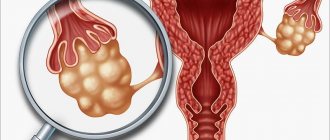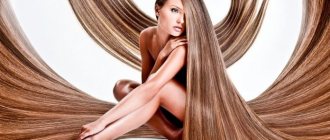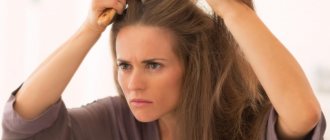According to statistics, every second woman has experienced intense hair loss in her life. And although a decrease in hair density cannot but upset you, you don’t need to immediately suspect that you have some kind of serious illness. Sometimes hair loss is just a temporary reaction of the body to stress, illness, medication, pregnancy and childbirth, or other unusual mental and physical conditions. There is no need to worry too much about this; hair growth will recover on its own without any additional products or procedures. However, if severe hair loss continues for several months and leads to a noticeable decrease in thickness, this is a reason to become concerned about the condition of the hair follicles and the entire body and take measures so as not to be left completely without hair.
Types of hair thinning in women
Androgenetic (androgenic) alopecia
Androgenetic alopecia (AGA) is the most common cause of hair loss in both men and women: it accounts for over 90% of all alopecia. Androgenetic alopecia does not impair a person’s physical health in any way. This is an exclusively cosmetic problem, but it significantly impairs the quality of life, causing psychological discomfort.
Androgenetic alopecia is found in people whose hair follicles are genetically sensitive to androgens (male hormones). In the presence of such sensitivity, dihydrotestosterone has a negative effect on the hair follicles, as a result of which they decrease in size, thin out and die over time.
Androgenetic alopecia changes the hair growth cycle. The active growth phase (anagen) is shortened, and the resting phase (telogen), when the hair does not grow, lengthens. The ratio of anagen to telogen periods becomes less than 8:1, with the norm being 12:1. With each cycle, the anagen phase becomes shorter and shorter, while the telogen phase remains the same. Changes in the hair growth cycle lead to shortening of the overall hair length. Over time, the size of hair follicles decreases. Normal, healthy, thick hair is replaced by thin (vellus) hair that appears unhealthy and sparse.
Female hair loss pattern
With androgenetic alopecia in women (female pattern of hair loss), the volume of hair in the frontoparietal zone decreases. Thinning on the crown is rare.
There are three stages of hair loss in women (according to the Ludwig scale): Stage 1 is characterized by noticeable thinning of hair in the frontoparietal zone and widening of the parting, while the marginal hairline remains unchanged. Stage 2 is diagnosed when there is severe hair thinning in the frontoparietal area. Stage 3 , in which hair in the frontoparietal zone is completely lost, is extremely rare.
Ludwig scale
Thinning in the central parting area
Thinning in the side parting area
Unlike men with androgenetic alopecia, women with the same diagnosis do not lose hair as intensely and abundantly, so there are practically no completely bald women. In addition, androgenetic alopecia begins to appear in women at a later age than in men and is more treatable.
The influence of hormones (androgens) on hair growth and loss
The effect of androgens on hair loss in men has been thoroughly studied and fully proven. As for women, in some cases there is indeed a relationship between hair loss and increased levels of male hormones in women (hyperandrogenism). In addition to hair loss, hyperandrogenism can also manifest itself with symptoms such as acne, hirsutism (increased facial and body hair), and menstrual irregularities. However, all these manifestations can occur even with normal levels of male hormones. Thus, hair loss that follows a female pattern is not always a consequence of hyperandrogenism. Genetic factors play a leading role in hair thinning in both women and men.
Treatment
Therapy with external and internal means
The most effective treatment for stopping hair loss and restoring hair growth is the following regimen: - Androgen receptor antagonists - cyproterone acetate (used in Europe and Canada) and spironolactone (used in the USA). These substances work to stop hair loss. — Hair growth stimulants – minoxidil, nitrolipins (Regeus).
Preparations containing these substances are applied externally directly to the areas of hair thinning and/or taken orally. The regimen and duration of treatment are determined individually. The earlier therapy is started, the higher its effectiveness. In later stages, when conservative treatment does not help, hair transplantation or the use of concealers is recommended.
Injections
The treatment method for androgenetic alopecia is based on the natural activation of regenerative processes. The essence of the method is to use your own cells, namely platelet-rich plasma. The drug is administered intradermally or subcutaneously, the course lasts at least 3 months. The treatment regimen is selected individually. Injection of platelet-rich plasma leads to the activation of key growth factors such as platelet-derived growth factor (PDGF), transforming growth factor (TGF), vascular endothelial growth factor (VEGF) and epidermal growth factor (EGF). This cascade of reactions leads to regeneration and repair and ultimately to the restoration of the physiological cycle of hair follicles.
Traditional methods of treating alopecia
There are many folk recipes for increasing hair thickness. The most popular of them are scalding masks based on pepper. In the scientific and medical community, this method of treating alopecia is treated with skepticism and humor. Pepper, although it increases blood flow while applying the mask, cannot thus restore the normal functioning of the hair follicles. Using traditional recipes is not only useless, but can also be dangerous for the skin. However, some people are confident in the effectiveness of such remedies. Here you can read where these beliefs come from: https://regeus.ru/blog/it-will-help-a-folk-remedy-to-stop-hair-loss-and-regain-hair-density
Hair loss due to menopause
A separate and fairly common type of alopecia in women is hair loss due to menopause. At the same time, the level of androgens (male hormones) in women can be either elevated or within normal limits. The classic treatment for alopecia caused by menopause is oral finasteride or dutasteride (prohibited for use in women in the Russian Federation). The dose and regimen are selected individually.
Diffuse alopecia
Other names: telogen effluvium, symptomatic alopecia, telogen effluvium hair loss. Telogen effluvium hair loss is characterized by the loss of more than 100 hairs per day, with hair falling out evenly over the entire surface of the scalp. Of the hair shed, most of it is in telogen rather than anagen.
Causes
Acute telogen effluvium occurs in childhood after infections, as well as in women from 30 to 50 years old and can last 3-6 months. In women of any age (including the elderly), acute telogen effluvium can occur against the background of androgenetic alopecia and aggravate its course. In such cases, the patient is given two diagnoses at once: androgenetic alopecia and diffuse alopecia, although this is quite rare.
“In my practice, there was such a case, and the patient was convinced that the doctors simply could not understand what was wrong with her, that the diagnoses differed and this aggravated her psychological state (and this could aggravate hair loss). Please trust your doctors, ask questions, study scientific articles if you don't believe anyone. The effectiveness of treatment depends on this. Fortunately, such types of diagnostics as trichoscopy and trichogram help in making both diagnoses.”
Elizaveta Dubinskaya Dermatologist, trichologist
Provoking factors for diffuse hair loss: surgical interventions, hospitalization, taking certain medications (neuroleptics, anticoagulants, interferons). If diffuse hair loss continues for more than 6 months with exacerbations, then a diagnosis of chronic telogen effluvium is made. There are two forms of such alopecia: - primary idiopathic, predominant in women before menopause; - secondary, occurring against the background of systemic chronic diseases (especially against the background of hypothyroidism), as well as against the background of conditions such as nutritional deficiency, stress, depression, malignant neoplasms. Young patients with seborrheic dermatitis also experience increased hair loss in the telogen phase, but this issue still requires clarification of the cause-and-effect relationship.
Diagnosis and treatment
The differences between diffuse and androgenetic alopecia are not always obvious; moreover, cases of transition from diffuse to androgenetic alopecia have been recorded (Sinclair et al., 2004). Non-invasive diagnostic methods: hair traction test, hair washing test, dermatoscopy and trichogram are sufficient to establish most diagnoses. Histological examination may help but is rarely required. To treat telogen effluvium, it is important to quickly identify and, if possible, eliminate the triggering factors. No special acute treatment is required, and most patients recover spontaneously within six months. The prognosis for chronic telogen effluvium is uncertain; spontaneous improvement may occur after several years.
Alopecia areata
Alopecia areata is a chronic disease of the hair follicles, manifesting itself in the form of round, non-scarring foci of hair loss on the head, and less often on the body.
Causes
Many authors consider the autoimmune nature of the disease, when cells of the immune system attack hair in the growth phase. The interaction of aggressive lymphocytes with hair follicle cells, abnormal expression of certain tissue antigens, and the initiation of apoptosis (programmed cell self-destruction) contribute to the development of autoimmune inflammation.
Among the factors contributing to the development of the disease: genetic predisposition, microcirculatory and immune disorders, endocrine and metabolic disorders, adverse environmental influences. In addition, nervous system disorders at various levels play an important role. The literature has now accumulated a lot of data indicating various emotional disorders, the presence of hypothalamic pathology and autonomic disorders in patients with alopecia areata.
How does alopecia areata manifest?
Clinical picture: - presence of alopecia foci on the skin with clear boundaries; - the presence of stumps of hair in the lesion in the form of an exclamation mark and a “loose hair zone” at the border of the lesion (active stage); - detection during microscopic examination of hair epilated from the lesion of dystrophic proximal ends in the form of a “broken rope”; - the presence of light vellus hair in the growth area (in the regression stage); - sometimes along one edge of the lesion there are fragments of hair in the form of an exclamation mark, and on the opposite - the growth of thin hair; - detection during examination of nails of signs of onychodystrophy: thimble-shaped indentations, longitudinal striations, changes in the free edge in the form of wavy patterns.
If the disease is less than 1 month old, the following subjective symptoms may occur: hyperemia, burning, itching in the area of hair loss.
Treatment
Considering the autoimmune mechanism for the development of baldness, the main therapeutic direction is immunosuppression.
In very severe forms, drugs from the group of glucocorticosteroids are prescribed orally. For milder forms, external treatment with drugs of the same group is used. Intradermal injections of diprospan are used simultaneously with the main line of therapy.
The course of the disease is often unpredictable; pathogenetic therapy does not always promote hair restoration and does not guarantee that there will be no relapses. To maintain hair growth, treatment must be continued until complete remission occurs.
Separately, it is worth mentioning the effectiveness of cryotherapy for the treatment of alopecia areata.
The effectiveness of cryotherapy for alopecia areata
Cryotherapy, a treatment with liquid nitrogen for the treatment of alopecia areata, is not widely used, although cryotherapy machines are available in dermatology offices.
The possibility of using cryotherapy in the treatment of alopecia areata was described back in 1986. The therapeutic effectiveness of surface cryotherapy has been proven in various studies. For example, studies have been conducted to evaluate the effectiveness of treatment of alopecia areata with cryotherapy (1 treatment every 2 weeks for 12 weeks) and 0.05% clobetasol propionate lotion. It was shown that despite the lack of complete hair restoration (>95%), the response to treatment was 80% and 91.5%, respectively. This indicator is considered very worthy, taking into account the almost complete absence of side effects with cryotherapy, in contrast to clobetasol propionate. In a large study conducted on more than 350 patients, it was shown that 61% of respondents experienced restoration of normal guard hair growth, and at the initial stage of the disease and short intervals between procedures (no more than 2 weeks), the proportion of positive results was higher.
A large retrospective study published in 2006 found that 68.6% of 153 patients with alopecia areata achieved significant hair improvement, including terminal hair growth within 12 weeks of treatment. In 2021, a prospective study was conducted to compare the effectiveness of superficial cryotherapy and topical steroids as a therapeutic option. It was shown that 73% of patients experienced hair growth after cryotherapy (including 13% who experienced complete restoration of the lesion). Along with the general clinical improvement, the number of terminal (guard) hairs on the treated part of the head significantly increased by 1.6 times, in contrast to the control part, on which no significant changes were observed. Of course, one should remember the possibility of spontaneous remission, which occurs in 34% ~ 50% of patients during the first year of the disease. However, it cannot be ignored that the positive treatment results obtained in the various studies described can be interpreted as a significant therapeutic effectiveness of cryotherapy in the treatment of alopecia areata.
Thus, due to the minimally painful nature of the damage during the procedure and minimally invasive effects, superficial cryotherapy has been found safe and effective in the treatment of alopecia areata.
Traction alopecia
Traction alopecia is hair loss due to external traumatic action on the hair follicle. The main reasons for the development of the disease: frequent tugging, improper combing and addiction to tight hairstyles, including tight ponytails, frequent twisting of hair into buns, tight curlers, backcombing, dreadlocks. As a rule, the most affected hair is along the forehead, on the back of the head and temples, in the parting area, between the braids.
At the initial stage, traction alopecia may manifest itself as soreness of the scalp. At this stage, the disease is easily treatable: it is enough to eliminate the traumatic factor, change the hairstyle, and hair growth is restored on its own. However, if the problem is neglected, irreversible processes may begin; the disease will progress to the stage of cicatricial alopecia, when the hair follicles cease to exist. Unfortunately, with cicatricial alopecia, no remedies will help restore hair growth.
What hairstyles are most likely to cause traction alopecia?
Dreadlocks
Once you have dreadlocks, a person can wear them for several years. To achieve this hairstyle, hair - natural and synthetic - is twisted together to lengthen and add volume. Because of this, the weight of the hair and the load on the hair follicle increases. In addition, the hair is constantly tense: stretched and fixed in one direction - this leads to its excessive fragility and breakage. If you decide to get dreadlocks, there is a risk that you will remove them along with all your hair. This is perhaps the most dangerous hairstyle.
Braids
Tight weaving of hair, joining in different directions, fixing in rows and lines when creating complex patterns severely injures the hair and provokes hair loss. Beautiful, complex weaves can be done sometimes, but for a daily hairstyle it is better to choose something else.
Bouffant
Backcombing also injures and damages strands, overloads the roots and can lead to hair loss. Hairstyles that require backcombing are also best done on special occasions and not overused. Otherwise, in an effort to have a voluminous hairstyle, you can lose this volume irrevocably.
Postpartum hair loss
Hair loss in women due to pregnancy, childbirth, and lactation is a normal physiological process caused by hormonal changes in the body. Treatment during this period is ineffective. Normally, hair growth should recover on its own within a year after giving birth. If after a year the hair is still falling out intensively and losing volume, this is an alarming symptom: it is necessary to start treatment as soon as possible.
Other types of hair loss in women
Unfortunately, hair loss is still a poorly studied area by science. In our article we have listed the main ones, but there are still many other types of hair loss that are extremely rare.
Strengthen hair with folk remedies
You can qualitatively strengthen your hair at home through unconventional cosmetology without any problems and effectively. Sometimes just changing your diet is enough. Typically, chicken meat, mushrooms, cottage cheese, eggs, rice, oatmeal, yeast, and brown bread contribute to strengthening.
The most reliable and proven method is rinsing with live beer. Naturally, the procedure is not carried out every day, but periodically giving your hair a “beer holiday” will be very useful. The roots become stronger and the hair becomes fuller.
A wonderful product is honey diluted with warm water. Propolis is often used, which is filled with vodka in a volume of 100 ml. The ingredients are carefully mixed and left on the head.
General recommendations for hair loss in women
What women experiencing hair loss need to remember is that the universal trigger for hair loss is stress. Sometimes the problem of hair loss can be eliminated by seeking help from a psychotherapist and reducing the level and intensity of negative experiences, depression, and irritation. In addition, it must be remembered that often in women, hair loss is not an independent disease, but a symptom of more serious disorders in the body. In this regard, in case of hair loss, you should consult a gynecologist, endocrinologist, gastroenterologist, therapist, dermatologist, and undergo a comprehensive health check to exclude the presence of pathologies that provoke hair loss. If a pathology is detected, it is necessary to treat the underlying disease and use external hair restoration products until the cause of hair loss is eliminated.
“To make a correct diagnosis, it is very important to carefully collect anamnesis and conduct an external examination of the entire scalp. Case study: a 33-year-old female patient has been experiencing hair loss for 3 years. History of polycystic ovary syndrome, autoimmune thyroiditis. After collecting complaints and anamnesis, she suggested a diagnosis: androgenetic alopecia. Trichoscopy in the parietal area did not reveal a typical picture. She examined the entire head and found that the patient had alopecia areata. On the scalp there are multiple small round and oval-shaped foci of baldness with a diameter of 0.3-0.5 cm. It turned out that there was a single foci of baldness in childhood, which resolved spontaneously. She ordered a blood test for syphilis, the result was negative. Having confirmed the diagnosis of alopecia areata, I chose the appropriate treatment tactics, although initially, it would seem, there were all the signs of androgenetic alopecia.”
Olga Fedina Doctor of the highest category, dermatologist, trichologist.
Products for hair strengthening and growth
Lifeless hair can become split due to weakened hair follicles that feed the hair follicles. If for any reason there are changes in the body and there are not enough useful components, then the growth rate decreases. It’s easy to get rid of the problem at home; all the recipes described above will return your hair to its former attractiveness.
Other effective means that have been passed on from one generation to another are also presented:
- Almond mask. Mix half a glass of nuts and milk; the consistency should be like sour cream. The composition is applied from the roots to the entire surface. The mask is washed off with regular shampoo.
- Yeast composition. Yeast is mixed with kefir and allowed to stand for 15 minutes. The pulp is placed on the head and wrapped in a bag. After 30 minutes you can wash it off.
- Yeast with mustard and honey. Approximately 10 grams of yeast are diluted with two spoons of water. Then kefir is poured in, sugar, mustard and honey are added. This paste should be kept for at least an hour.
The beautiful half of humanity has long been saved by folk products and recipes. About 95% of women respond positively, because folk cosmetics are of very high quality and effective. Most people prefer masks made from kefir or mumiyo.
Additional materials
Home test for hair loss
Run your fingers through your hair, pinch the hair between your fingers, pull out the strands, sliding along them. Don't pull out your hair! There should be no pain during traction. Count how many hairs you pulled out.
- If you have less than 6 hairs in your hand, congratulations! There's nothing wrong with your hair.
- If there are more than 6 hairs, hair falls out beyond normal.
Hair roots require attention and care. Before the test, it is advisable not to wash your hair for 5 days. The test can be repeated on different parts of the head to determine which areas are experiencing intense hair loss. If hair loss in the frontal-parietal zone is above normal, and in the back - within normal limits, then with a high degree of probability, androgenetic alopecia can be diagnosed.
List of primary diagnostic procedures for hair loss in women
- Blood test: general, hormones (DHEA sulfate, testosterone, androstenedione, prolactin, follicle-stimulating hormone, luteinizing hormone, antibodies to TPO, T4, TSH), iron, ferritin, TSH.
- Test for syphilis.
- Computer diagnostics of the scalp and hair (trichogram or phototrichogram). Computer diagnostics will allow you to determine the type of hair loss: under high magnification, the doctor looks at the condition of the follicles, the ratio of normal, vellus and thinning hair, and checks whether there is inflammation of the skin. The phototrichogram shows the growth rate, density, percentage of hair growing and falling out. In the Regeus laboratory you can get a trichogram for free:
- Additionally, in case of pathology of the hair shaft, it is necessary to conduct a spectral analysis of the hair for microelements.
Authors: Elizaveta Dubinskaya, Olga Fedina, Melanya Aidinyan
Rules for using masks against hair loss
Before using a mask that prevents hair loss, be sure to make sure that you are not allergic to any component. You should also follow all the rules to choose your individual hair type. It is enough to follow a few simple recommendations:
- Rinse your hair with running water, not hot water. In the bathhouse, be sure to wear a special cap.
- Dry naturally, wrap your head with a towel that absorbs moisture well.
- If you need to dry quickly, then set the hairdryer to the minimum setting, so they won’t dry out and the ends won’t split.
- Choose only good combs and combs.
- Treat your head with a massage occasionally.
- Apply different oils periodically, do not overdo it, otherwise your hair will become greasy.
After consulting with a doctor and finding out the cause of the loss, you can use the recommendations of specialists. In this situation, folk remedies will instantly correct your problem.










